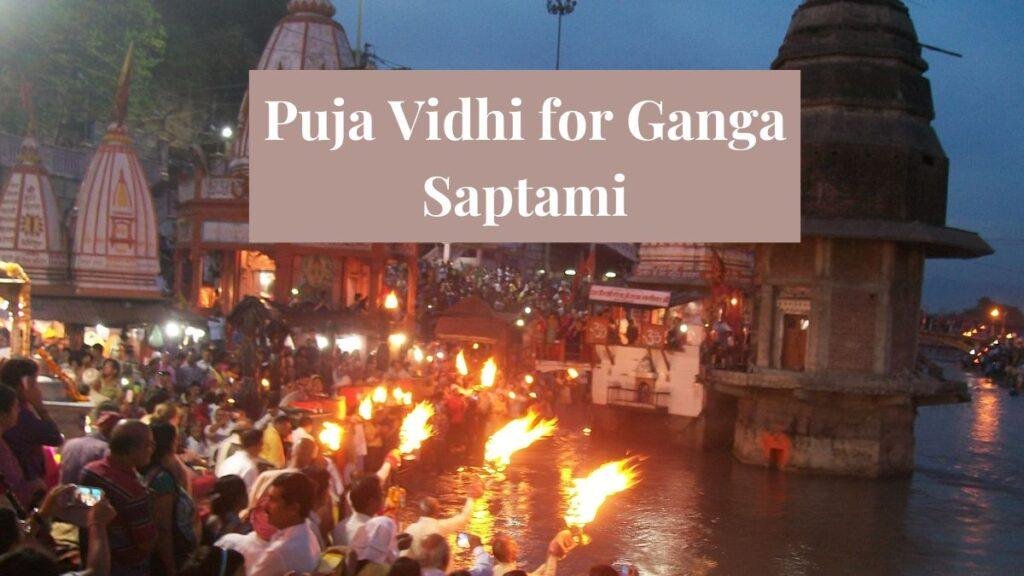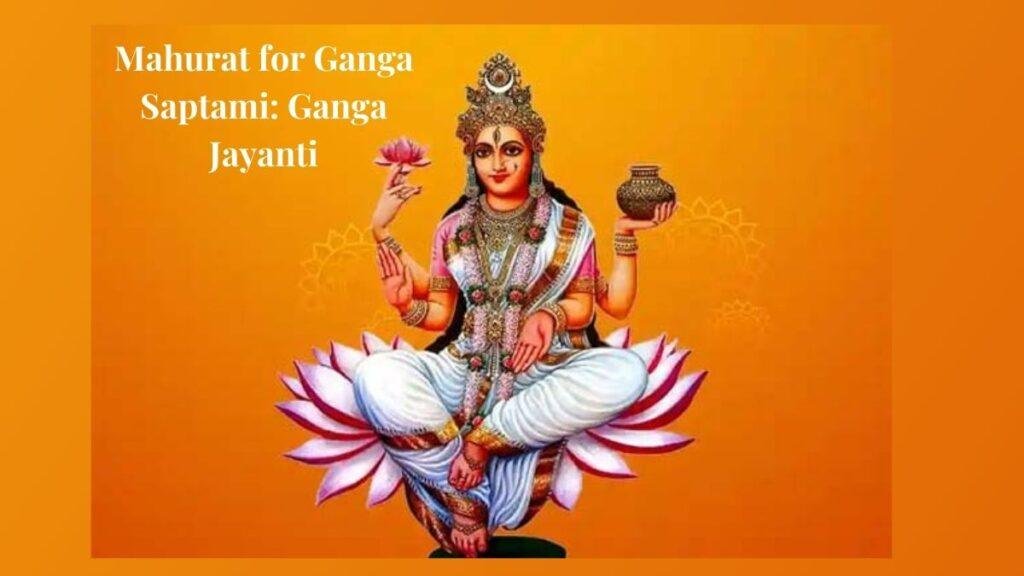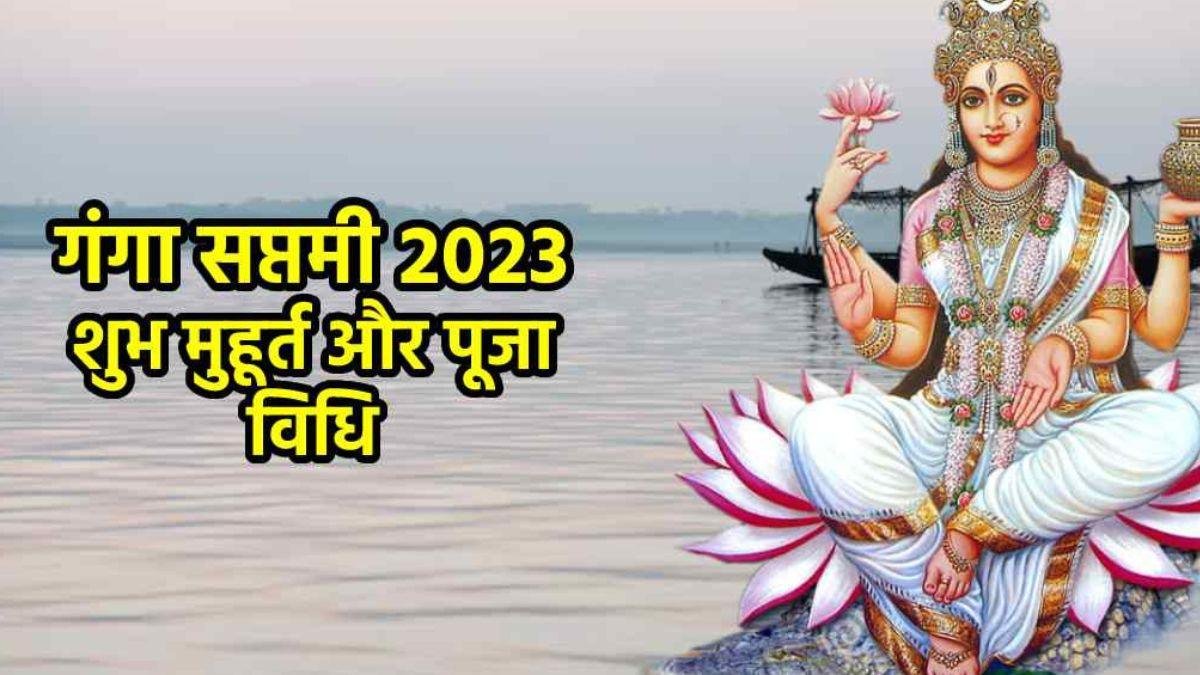Ganga Saptami, also known as Ganga Jayanti, is a significant Hindu festival that celebrates the descent of the goddess Ganga to Earth. This festival is celebrated with great fervor and devotion across India, especially in regions where the river Ganga flows. The festival falls on the seventh day (Saptami) of the waxing phase of the moon (Shukla Paksha) in the Hindu month of Vaishakha. In 2024, Ganga Saptami will be celebrated on 14th May.
The river Ganga holds a special place in Hindu mythology and is considered a sacred river that purifies the soul of those who bathe in its waters. The festival of Ganga Saptami is a celebration of the river’s significance and the goddess Ganga’s role in bringing divine energy to Earth.
During Ganga Saptami, devotees perform various puja rituals to seek the blessings of the goddess Ganga and offer prayers for their spiritual and material well-being. The puja vidhi for Ganga Saptami involves specific steps and mantras that are recited to invoke the goddess’s divine energy and seek her protection.
In this article, we will dive into the significance of Ganga Saptami, the mythological story of Ganga’s descent to Earth, and the symbolic significance of the river Ganga in Hinduism. We will also explore the puja vidhi, including the preparations, items required, puja rituals, and the significance of each step in the puja vidhi. Additionally, we will discuss the auspicious timings for performing the puja during the mahurat and the benefits of performing the puja during this time.
Significance of Ganga Saptami
Ganga Saptami is not just another festival for Hindus, but a day that holds a deeply emotional significance. It is a day that reminds us of the mythological story of Ganga’s descent to Earth, a story that has been passed down from generation to generation. According to Hindu mythology, Lord Brahma had requested Ganga to come down to Earth to cleanse the souls of his ancestors. However, the force of Ganga’s descent was so powerful that Lord Shiva had to intervene to prevent the Earth from being destroyed. Lord Shiva then captured Ganga in his locks and released her in small streams, which eventually flowed into the river Ganga that we know today. This story holds a special place in the hearts of many Hindus, as it signifies the power of the divine to intervene and protect us in times of danger.
The river Ganga holds a symbolic significance in Hinduism that goes beyond just a source of water. It is believed to be the most sacred river in Hinduism, with the power to wash away one’s sins and bring spiritual purification. The river is considered to be the physical manifestation of the goddess Ganga, who is worshipped by Hindus all over the world. For many Hindus, the Ganga represents purity, divinity, and the ultimate source of spiritual cleansing. The river is used in many Hindu rituals, and its water is considered to be holy and life-giving.
Bathing in the Ganga on Ganga Saptami is believed to have immense spiritual significance. It is said to wash away one’s sins and bring spiritual purification. The river is believed to have healing properties, and its water is used in many Hindu rituals, including the puja vidhi for Ganga Saptami. For many Hindus, taking a dip in the Ganga on this day is a way to connect with the divine, to seek blessings and to find inner peace.
Puja Vidhi for Ganga Saptami

The puja vidhi for Ganga Saptami is a sacred ritual that is performed by Hindus to seek the blessings of the goddess Ganga. The following is a step-by-step guide on how to perform the puja vidhi, along with the items required and the significance of each step.
Preparations for the puja
- Clean the puja area and decorate it with flowers and rangoli.
- Arrange all the required items for the puja, including flowers, incense sticks, camphor, a lamp, and offerings such as fruits, sweets, and betel leaves.
- Take a bath and wear clean clothes.
Puja rituals and steps
- Begin the puja by lighting the lamp and offering incense sticks to invoke the blessings of the goddess Ganga.
- Chant the Ganga Saptami mantra, “Om Gangai Namaha” or “Om Namaha Shivaya” to seek the blessings of Lord Shiva, who is believed to have released Ganga on Earth.
- Offer flowers and fruits to the goddess Ganga and sprinkle Ganga jal (holy water of the river Ganga) on the idol or photo of the goddess.
- Offer camphor to the goddess and light it, symbolizing the destruction of ignorance and the attainment of knowledge.
- Recite the Ganga Saptami Stotram, a hymn in praise of the goddess Ganga, and offer prayers to seek her blessings.
- Finally, perform the aarti by waving the lamp in a circular motion, and offering it to the goddess.
Significance of Each Step in The Puja Vidhi
- Lighting the lamp and offering incense sticks is a way to invoke the blessings of the goddess and create a sacred environment.
- Chanting the Ganga Saptami mantra and the “Om Namaha Shivaya” mantra is believed to bring peace and purify the mind and soul.
- Offering flowers and fruits to the goddess and sprinkling Ganga jal is a way to honor the goddess and seek her blessings.
- Lighting the camphor signifies the destruction of ignorance and the attainment of knowledge.
- Reciting the Ganga Saptami Stotram is a way to praise and seek the blessings of the goddess.
- Finally, performing the aarti symbolizes the completion of the puja and the offering of the lamp to the goddess as a way to seek her blessings.
Some Specific Mantras For Puja
Here are some specific mantras that can be recited during the Ganga Saptami puja vidhi:
Ganga Saptami Mantra: “Om Gangai Namaha”
This mantra is a powerful invocation of the goddess Ganga, and it is believed to bring peace and purification to the mind and soul. By reciting this mantra, devotees seek the blessings of the goddess and invoke her divine energy.
Om Namaha Shivaya Mantra:
This mantra is a powerful invocation of Lord Shiva, who is believed to have released the river Ganga on Earth. Lord Shiva is also known as Gangadhara, the holder of the river Ganga, and reciting this mantra is a way to seek his blessings and protection.
Ganga Stotram:
The Ganga Stotram is a hymn in praise of the goddess Ganga, and it is recited during the Ganga Saptami puja vidhi. This hymn describes the glory of the river Ganga and its importance in Hindu mythology. Here is an excerpt from the Ganga Stotram:
“”Salutes to the Ganga, the daughter of the mountain king, Himalaya.”
She is the embodiment of purity and sanctity, and she is the sustainer of the three worlds. She is the remover of sins and the giver of salvation. Salutations to the goddess Ganga.”
Ganga Gayatri Mantra:
The Ganga Gayatri Mantra is another powerful invocation of the goddess Ganga, and it is recited to seek her blessings and protection. Here is the Ganga Gayatri Mantra:
“Om Bhagirathaya Vidmahe
Ganga Devaya Dheemahi
Tanno Ganga Prachodayat”
This mantra translates as “We meditate on Bhagiratha, who brought the Ganga to Earth.” We invoke the blessings of the goddess Ganga, and we pray that she may guide and protect us.”
Mahurat for Ganga Saptami: Ganga Jayanti

Ganga Saptami is an auspicious day in the Hindu calendar, and performing the puja during the mahurat is believed to bring great benefits and blessings. The Ganga Saptami puja timing are as follows:
Ganga Saptami on Tuesday, May 14, 2024
Madhyahna Muhurat Start– May 14 | 2:56 AM in (United States)
Madhyahna Muhurat End– May 14 | 5:36 AM in (United States)
Duration: 2 hours 40 mins
Ganga Dussehra on Sunday, June 16,2024
Saptami Tithi Begins– May 13 | 5:20 PM in (United States)
Saptami Tithi Ends- May 14 | 6:49 PM in (United States)
The Madhyahna Muhurat is considered the most auspicious time to perform the puja, as it is believed that the energy of the divine is at its peak during this period. It is recommended to perform the puja during this time for maximum benefits.
Performing the puja during the mahurat is also believed to ensure success and prosperity in all endeavors, as well as protect the devotee from negative energies and evil forces. It is said that the blessings of the goddess Ganga are showered upon the devotee during this time, and any spiritual or material goals are fulfilled with ease.
Conclusion
Ganga Saptami is a significant Hindu festival that celebrates the goddess Ganga’s descent to Earth and the symbolic significance of the river Ganga in Hinduism. The festival is celebrated with great devotion and enthusiasm, and devotees perform various puja rituals to seek the blessings of the goddess Ganga and offer prayers for their spiritual and material well-being.
The puja vidhi for Ganga Saptami involves specific steps and mantras that are recited to invoke the goddess’s divine energy and seek her protection. It is recommended to perform the puja during the mahurat, which is the most auspicious time for performing the puja and is believed to bring great benefits and blessings to the devotee.
In conclusion, Ganga Saptami is an important festival that highlights the significance of the river Ganga in Hinduism and provides an opportunity for devotees to seek the blessings of the goddess Ganga. Through the puja rituals and devotion, devotees can connect with the divine and experience the purity and sanctity of the sacred river.



















Add comment